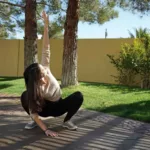“Sitting is the new smoking” is definitely an exaggeration, but there’s no denying that most of us are glued to our seats far too often. Whether it’s behind a desk, in the car, or lounging at home, we’re spending hours stuck in one position—and our bodies are paying the price.
Tight shoulders, a stiff back, and inflexible hips are all too common.
But this isn’t just about discomfort; it’s about how much this impacts your overall quality of life.
It’d be great if there was one exercise that could be the antidote to all those aches, stiffness, and postural woes. An exercise that not only counters the negative effects of prolonged sitting but also builds full-body strength and mobility. Sounds too good to be true?
Well we’ve been teaching this one for years and thousands of our clients have benefited.
From Slumped to Strong: The Three-Point Bridge
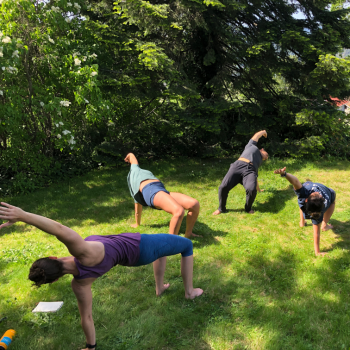 As you can see the Three Point Bridge is a pretty unique exercise; it’s a position that combines a lot of movement that most people just don’t do too often. And that’s why it’s so helpful!
As you can see the Three Point Bridge is a pretty unique exercise; it’s a position that combines a lot of movement that most people just don’t do too often. And that’s why it’s so helpful!
In our daily lives, our actions are predominantly forward-focused. We bend forward to tie our shoes, reach forward to grab our coffee, and sit in a position that keeps our body flexed.
We need to spend some time doing the opposite! Bending back and rotating and stretching the front of our body so we don’t lose access to those motions.
Ready to dive in? Here’s three steps to get you going!
1. Begin In A Squat That’s Best For You
Begin by sitting in a squat. You don’t need to go too low – find a comfortable stance.
Extend one hand behind you, roughly a hand’s distance from your hips. Depending on your shoulder flexibility, you might find it helpful to position your hand slightly to the side.
Don’t be afraid to play and wiggle around a bit, how far apart your feet are, the angle and position of your hand, and how much your knees are bent are all up to you and how you feel. And remember this changes as you continue to practice!
Take your time with every setup for the Three Point Bridge.
And for every exercise for that matter!
2. Get Your Hips Up
When you do a movement skill, it’s best to have a primary intention.
Something that will be the key cue to keep in mind throughout the exercise performance. For now, let’s make the primary goal to lift your hips up. Push through your heels and get your hips up high!
Think of this as your anchor movement; this is the key intention, do this well and everything else will follow.
3. Roll Out, Reach Up, Look Back
Your supporting hand should be a stable base, so push firmly into the ground. And as you do this focus on rolling your shoulders outward, this engages your shoulder rotator cuff and aids in improving your stability.
It’s also a big part of the benefit of this exercise. The coordination of your shoulder girdle and rotator cuff muscles, along with your back, core, and hips really helps to address a lot of issues related to stress and overuse.
As you become more comfortable, raise your other hand behind you, turning your gaze towards it. Rotate towards your supporting hand, gradually shifting more weight onto it as you gain confidence.
The Movement Your Body Craves
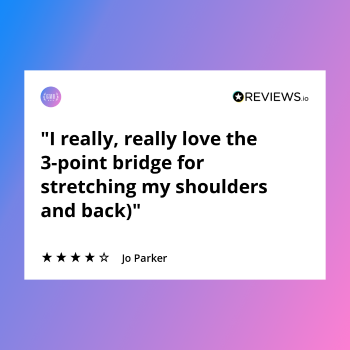 The Three Point Bridge takes us away from habitual forward flexion. The exercise promotes spinal extension, hip and core strength, and shoulder extension. All very important and all often sorely neglected.
The Three Point Bridge takes us away from habitual forward flexion. The exercise promotes spinal extension, hip and core strength, and shoulder extension. All very important and all often sorely neglected.
By rolling our shoulders outward, reaching back, and pushing our hips forward, we’re extending and opening up the front of our body. It’s giving your body a much-needed stretch in the opposite direction, counteracting the flexed position we find ourselves in throughout the day.
This exercise is taking your body by the hand and saying “Come on, let’s move this way for a change!”
Find the Three-Point Bridge Challenging? Follow This Strategy for Success
As we talked about above, this movement can be incredibly beneficial because it is so unlike what you do throughout the day. But this very fact can also make it frustrating and difficult to do in your first few attempts. We’ve seen this in so many clients, you are not alone!
With this in mind, starting out with a couple of other movements can be a beneficial first step.
Lounge Chair
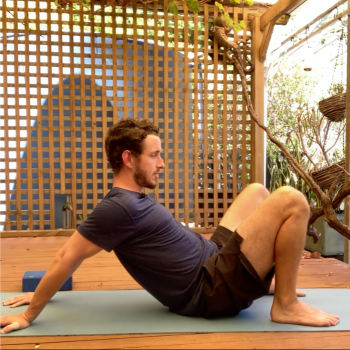 This exercise focuses primarily on your shoulders and chest, to help reduce tightness and get you used to pressing your hands behind you.
This exercise focuses primarily on your shoulders and chest, to help reduce tightness and get you used to pressing your hands behind you.
The key here is to not let your shoulders round forward, just reach back far enough that you feel a tug at your shoulders and chest but not too far that you can’t control your shoulders from hunching in front of you.
One of the main benefits here is that you can shift more of your weight onto your hips and legs and control how much pressure there is on your hands. This can help you to relax more and focus on rotating your shoulders out and pulling them back.
Supine Tabletop
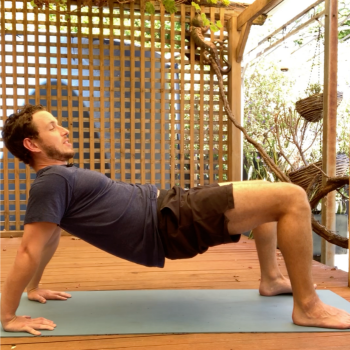 Sit down with your feet a comfortable distance away from your hips and place both hands behind you. Here, using both of your arms spreads your weight more evenly and you can focus on your shoulder positioning and lifting your hips up high.
Sit down with your feet a comfortable distance away from your hips and place both hands behind you. Here, using both of your arms spreads your weight more evenly and you can focus on your shoulder positioning and lifting your hips up high.
The same cues as for the Three Point Bridge also fit with these exercises. Think about pushing your hips up to the sky and opening your chest and shoulders.
Do five repetitions of moving up and down and then hold the position for 15 seconds or so, and build up to longer as you get more comfortable.
From Stuck to Unstoppable: Learn to Modify and Adapt
These positions can serve as a primer, helping you ease into the mechanics of the movement. But please don’t think that you need to do a few weeks of this before even starting to try the Three Point Bridge. It’s much better to just begin where you are at and learn to adjust and tailor the exercise to align with your current capabilities.
This adaptability is a cornerstone principle in the GMB Method.
When we talk about mastering a movement, it’s not always about following a rigid, step-by-step progression. One of the wonders of our bodies is the capability to adapt and get better. This is the very basis of exercising to improve ourselves.
If our bodies didn’t adapt we would just stay the same!
Every individual has a distinct way of moving, and what works best for one might not be ideal for another. Recognizing this, you’ll find that every movement, every position can be adjusted and modified to suit you. This principle isn’t just applicable to exercises; it mirrors our daily lives. Each day presents its own set of challenges, and similarly, every workout can feel different from the last. This dynamic nature of our bodies and routines is precisely why we emphasize the concept of autoregulation so much.
So, as you learn and practice the three-point bridge, remember: it’s not about perfection from the get-go, but about practicing and learning how to adapt and progress according to your needs.
Beyond the Basics: The Power of Motion and Variety
View this post on Instagram
If we can get people to do one thing to improve their fitness and the way they move, it’d be to actually move!
As we’ve talked about before in regards to the resting squat, people get too fixated on getting “perfect” before they work on something. When, for most people for most of the time, they would be much better off doing what they can with what they have.
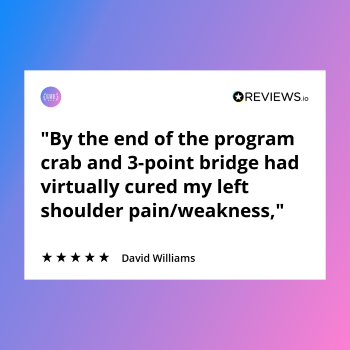 Practice with mindful control and relative safety and go ahead and try and explore your movement. This is at the heart of bodyweight locomotion training and why we have had so many clients write in and tell us how they’ve broken through barriers they’ve been dealing with for years.
Practice with mindful control and relative safety and go ahead and try and explore your movement. This is at the heart of bodyweight locomotion training and why we have had so many clients write in and tell us how they’ve broken through barriers they’ve been dealing with for years.
After a couple few sessions of getting familiarized with the Three Point Bridge, combine it with movement side to side and forward and back. Congratulations you’re now doing a Crab locomotion!
Putting your body in motion, in a variety of different ways and exploring how it feels and how your body reacts is one of the “secrets” to improving and building your physical capabilities and resilience.
Your Answer to Persistent Mobility Issues
The Three Point Bridge helps you on the path to better mobility, strength, and overall well-being. It should definitely be a part of an adaptable and progressive program. Get going now and with consistent practice you can combat tightness and reclaim your flexibility.
Systematic and Adaptable Training
Our Elements program adapts and changes to your needs, providing you with the tools to improve your physical capabilities and resilience for every aspect of your life.




